Weekly briefing: China holds on box market action; pessimistic oil forecasts
Capacity discipline and consolidation have kept freight rates at elevated levels this year, but China is asking questions about why cost savings from low oil prices and reduced port fees have not been passed on
After inviting container carriers to discuss record rates on transpacific trades last week, China has for now decided against direct intervention into the market. Elsewhere, floating storage looks like it could be the main driver behind earnings in the tanker market for the remainder of the year as oil demand remains subdued
THIS weekly briefing provides sector-by-sector coverage of the biggest news and analysis in shipping.
Follow the links within the text to the relevant news items in each market segment
Containers
Regulation raised its head in the world of container shipping this week, with both China and the European Union threatening to intervene in the way the sector does its business, each in ways that could be regarded as detrimental.
China started the ball rolling when it invited carriers to a “consultation” to explain how they could curb the excessively fast mark-ups on China-US trades, and to pass on the cost savings from the drop in oil prices and reduction of port fees.
While Chinese authorities appear to have refrained from direct intervention, the move is a shot across the bows of the container shipping sector, and its efforts to maintain rates through capacity management.
That has kept the sector thriving in what would otherwise have been a disastrous year for carriers, which saw volumes fall by around 15% in the second quarter. While peak season demand has increased this year when compared to 2019, liftings are still expected to be down 5%-7% across the year.
Normally that would have led to falling rates, but carrier consolidation and discipline has seen a joint-forces approach that has kept rates strong, with the Shanghai Containerised Freight Index breaking records nearly every week for the past month.
Any intervention by regulators could see this discipline falter, and with it the high rates and profitability that box lines have achieved this year.
How effective the threat will be remains to be seen, but already Cosco-owned Orient Overseas Container Line has dropped a plan to blank a series of transpacific sailings.
In Europe, the regulatory assault came on the environmental front, when the European Parliament voted in favour of a proposal to include shipping in the EU Emissions Trading System.
Under the adopted proposals, large ships calling at ports in Europe will need to cut their carbon intensity by at least 40% by 2030.
The World Shipping Council, which represents the major container lines, called on the EU to reconsider its plans to include shipping in the bloc’s cap and trade emissions system.
The WSC wants the EU to apply the ETS and the operational efficiency measures to intra-EU voyages only, noting that most of the voyages the regulation covers happen outside EU waters.
It estimated that with a €25 ($29.60) tax on each tonne of carbon and based on the commission’s 2018 data on vessel voyages, the EU would generate €3.5bn from vessel port calls. Carriers would pay a significant part of that.
Tankers
Home working and air travel restrictions are underpinning fresh pessimistic forecasts about oil demand growth for the remainder of 2020.
It leaves floating storage deployment as the biggest driver of fourth-quarter tanker earnings amid stalling consumption of land and air transport fuels that will deepen crude and refined product contango spreads.
The International Energy Agency lowered its second-half oil demand forecast for its second consecutive oil monthly report, saying 2020 demand would be 91.7m barrels per day. That is 400,000 bpd below its prior estimate in August, and 8.4m bpd below 2019 levels.
The report makes grim reading for owners and operators of the global fleet of crude tankers, which last year shipped about 50m bpd of the world’s estimated supply of 100m bpd of crude and condensate.
At the height of lockdown restrictions in April and May, demand for refined products slumped by one third, while oil prices plunged to a 21-year low, triggering contango market conditions that saw tankers deployed for floating storage at record levels through to August.
Stockpiles of crude are at multi-year highs and this is likely to have an adverse effect on the oil trade and associated shipping demand, Trafigura’s co-head of oil trading Ben Luckrock told a conference this week.
China has added some 800m barrels to its stocks, which have essentially doubled since the start of 2020, he added. Mr Luckrock suggested that China will take at least two years to exhaust such “excess materials” even if its demand more than claws back coronavirus-triggered losses to rise 1m barrels above the 2019 level.
Oil prices rose this week as Hurricane Sally neared landfall in the US, forcing the shutdown of more than a quarter of offshore Gulf of Mexico crude production and a number of refineries.
Meanwhile, a cargo of Iranian condensate is discharging in Venezuela at Puerto Jose port after sailing from Iran without transmitting any Automatic Identification Signals for the entire voyage in breach of international safety shipping regulations, to avoid revealing its location and destination.
The 2m-barrel shipment on board the National Iranian Tanker Co-owned very large crude carrier is the latest sanctions-evading tactic used by the Islamic republic to keep up shipments of crude, condensate, fuel oil and liquefied petroleum gas, and further illustrates deepening ties between the two countries.
Dry Bulk
The latest Chinese customs data suggests the country’s strained relationship with Australia is starting to have an impact on trading relations, which will set alarm bells ringing in the dry bulk market.
Tensions between China and Australia have escalated after the latter pushed for an independent inquiry into the origins of the coronavirus pandemic, in addition to banning Chinese telecoms company Huawei from participating in Australia’s 5G network.
In response, China slapped trade sanctions on barley and beef exporters and has warned that it could swap Australian iron ore for African iron ore.
The tensions did little to damage the trading relationship between the two countries in the opening half of the year, with the value relatively steady, but August saw a sharp 26.2% drop.
Mining giant BHP will seek to improve the emissions efficiency of its products’ shipping by 40% by 2030 in line with global maritime goals.
The major dry bulk charter has unveiled its climate change report in which it details its environmental aspirations, including its ambition to align with the targets set out by the International Maritime Organization.
BHP has also committed to achieving net zero operational emissions by 2050. In the past year, it launched a climate investment programme in which it will pour $400m over the course of five years for emission-reduction projects.
Last week, it was disclosed that BHP has agreed to charter five liquefied natural gas-fuelled newcastlemax bulk carriers from Eastern Pacific, following a tender BHP had issued in 2019.
The port of Santos is imposing stricter inspection and access rules on older ships as part of a new berthing and mooring policy.
Brazil’s biggest port will not be accepting vessels built before 1990, unless those ships have documents that prove they have been retrofitted, Brazil P&I Club reported.
Additionally, vessels built before 2002 may be subject to Port State Control inspections and will need to have a P&I certificate as well as confirm they have wreck removal cover.
Finally, dry bulk carrier Tomini Majesty became the latest vessel to become embroiled in the wider crew-change crisis when its 21 Ukrainian crew members threatened to go on a hunger strike after being stuck on the vessel for at least a year, according to Lloyd’s List Intelligence reports.
The planned strike was averted at the last minute but is the latest episode in the crew’s long battle with the vessel’s owners to get back home.
Lloyd’s List Awards
Due to a high number of entries, the submission deadline for the 2020 Lloyd's List Awards has been extended to September 25.
The adaptability and sheer determination of companies and seafarers to keep the world moving is a theme that has run through Lloyd’s List’s reporting this year.
That is why we have set aside our usual awards portfolio and are offering the Lloyd’s List Awards 2020 as a platform for those stories to be told.
A revised list of categories and criteria has been created to recognise not only high standards in maritime, but also the resilience and innovation shown by the industry in the face of unprecedented adversity.
If you are in search of inspiration as to how to approach your entry, the Lloyd’s List team has put together an article featuring some top tips to get your company noticed and ensure it does not fall foul of the entry rules. It can be viewed here.
To start your entry, follow this link or click on the banner below.




